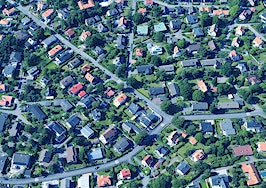Would you like a more effective way to generate leads without having to pound on doors or pick up the phone to call strangers? If so, a digital door-knocking campaign combined with geo-fencing is a powerful new approach to lead generation that delivers real results.
Digital door-knocking focuses on short-form digital communication, including traditional email, video-email, text messaging, digital ads, tweets and short-form videos on platforms such as Instagram and TikTok.
The typical goal is to build a database of 150 people who will send you one to two referrals per year. To achieve this goal, many experts advocate making a minimum of five thoughtful comments daily on the social media feeds of the most important 150 people in your referral database.
Touch 76 people per day
Real estate coach Hank Avink has created what he calls the “50-20-5-1” approach to converting leads from the social media. This approach generates 76 “touches” per day as opposed to only five that most other approaches generate.
Here’s how it works:
- Like, give a thumbs-up or “heart” 50 of the posts from your social media contacts.
- Make short comments (“Congratulations,” “Happy Birthday,” etc.) on another 20 contacts.
- Have deeper conversations with five of your contacts.
- Have a life-changing, in-depth conversation with one person daily.
What can geo-fencing do that other digital door-knocking tools can’t do?
Stacey Soleil recently wrote an excellent article that illustrates how most agents think of digital door-knocking. Each of the strategies she outlined, however, only result in a single impression, either by texting or by posting on the social media.
Geo-fencing allows you to conduct digital door-knocking campaigns based on geographical locations rather than online locations such as Facebook and Instagram. Geo-fencing also enables you to make multiple impressions over a 30-day period, rather than only one impression per post using traditional methods.
So, what exactly is geo-fencing?
Although you might not be familiar with the term “geo-fencing,” you are probably aware of tools like Amazon’s Alexa, Google’s Echo, Nest thermostats and other tools that use geo-fencing to control systems in your home remotely.
When it comes to marketing, however, BuildFire explains it as:
Geo-fencing is a technique of serving smartphone users with ads that are relevant to them, by creating a virtual perimeter or boundary around your business location which notifies users as soon as they enter the boundary. In other words, geofencing can be regarded as a mobile marketing optimization strategy.
Unlike print marketing that creates a single impression that lasts for a few seconds before your print marketing piece goes in the trash, geo-fencing allows you to make multiple impressions over a 30-day period (typically three to six per day) or up to 180 impressions in a single month for approximately $1.50 to $5 “per door.”
Your ad is visible whenever someone “crosses the boundary” of your geo-fence in real time. After that, your ad follows the individual across their various digital devices in much the same way that Facebook retargeted ads follow you after you leave Facebook and visit other websites.
Three companies currently offer geo-fencing services for real estate professionals, and they include Klevrleads, Propellant Media and Thumbvista.
Types of ads
Here are two examples of the types of geo-fencing ads McDaniel uses. The first ad can be used for open houses while the second one can be used for working with local businesses to jointly market your respective services.
If you geo-fence an open house, you could run the following ad that would appear on people’s mobile devices as they exit the property:
If you liked 123 Main Street, you’ll love 456 Maple. It’s open today from 1-4 p.m.
Caveat: If you use this approach, you must exclude any digital devices owned by the occupants/owners of the house you are geo-fencing.
McDaniel also geo-fences a local pizza restaurant. He has had great success with the following ad that people see on their phone as they walk into the restaurant:
Buy one, get one free, courtesy of the McDaniel Callahan Real Estate team. Use the code “McDaniel.”
The restaurant owner also loves it!
How to use geo-fencing in your business
There are hundreds of ways to use geo-fencing in your real estate business. Here are a few examples. You can place a geo-fence around:
- 100 homes located near your new listing.
- Current and past clients (keep ads relevant to their specific interests).
- All your listings (geo-fencing enables you to serve up an ad for your listing when someone stops in front of your yard sign or takes a brochure from your brochure box).
- Open houses.
- New home sites.
- Areas where there is high demand for homes.
Also, here’s another great reason to use geo-fencing. When sellers want you to do more print advertising, show them how your approach can generate up to 180 impressions a month versus print advertising that only generates a single impression.
Potential ethical challenges with geo-fencing other people’s listings
As with any new technology, there are virtually no rules or guidelines about what is and is not allowed when it comes to geo-fencing.
Before you decide to geo-fence a competitor’s listing, avoid violating the National Association of Realtors (NAR) Code of Ethics regarding the solicitation of other agents’ active listings by using either of the following two strategies:
- Instruct your geo-fencing provider to make sure no ads are placed on any devices associated with the seller’s address.
- You could also use the print marketing disclaimer Realtors have used for decades that states, “Not intended to solicit buyers or sellers currently listed with a different brokerage.” Given the short-form nature of many geo-fencing ads, however, this may not be practical.
The bottom line is geo-fencing is rapidly expanding across multiple industries, whether it’s the shoe store that sends you a 10 percent discount coupon as you walk into their store, political campaigns trying to win your vote, or a retailer who sends you a buy-one-get-one-free offer when you walk past their place of business.
Implementing this technology now can give you a significant edge over those who are relying on more traditional digital or print marketing strategies. Furthermore, it can also be a powerful method for persuading sellers to list with you due to your innovative use of cutting-edge technology.
Bernice Ross, President and CEO of BrokerageUP and RealEstateCoach.com, is a national speaker, author and trainer with over 1,000 published articles. Learn about her broker/manager training programs designed for women, by women, at BrokerageUp.com and her new agent sales training at RealEstateCoach.com/newagent.









